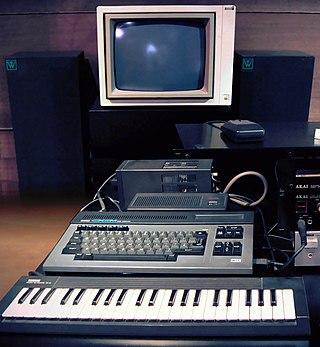grep is a command-line utility for searching plain-text data sets for lines that match a regular expression. Its name comes from the ed command g/re/p, which has the same effect. grep was originally developed for the Unix operating system, but later available for all Unix-like systems and some others such as OS-9.

MSX is a standardized home computer architecture, announced by ASCII Corporation on June 16, 1983. It was initially conceived by Microsoft as a product for the Eastern sector, and jointly marketed by Kazuhiko Nishi, the director at ASCII Corporation. Microsoft and Nishi conceived the project as an attempt to create unified standards among various home computing system manufacturers of the period, in the same fashion as the VHS standard for home video tape machines. The first MSX computer sold to the public was a Mitsubishi ML-8000, released on October 21, 1983, thus marking its official release date.

head is a program on Unix and Unix-like operating systems used to display the beginning of a text file or piped data.
MSX BASIC is a dialect of the BASIC programming language. It is an extended version of Microsoft's MBASIC Version 4.5, adding support for graphic, music, and various peripherals attached to MSX microcomputers. Generally, MSX BASIC is designed to follow GW-BASIC, released the same year for IBM PCs and clones. During the creation of MSX BASIC, effort was made to make the system flexible and expandable.
The Stanford Graduate School of Business is the graduate business school of Stanford University, a private research university in Stanford, California. For several years it has been the most selective business school in the United States, admitting only about 6% of applicants.

wc is a command in Unix, Plan 9, Inferno, and Unix-like operating systems. The program reads either standard input or a list of computer files and generates one or more of the following statistics: newline count, word count, and byte count. If a list of files is provided, both individual file and total statistics follow.

ASCII Corporation was a Japanese publishing company based in Chiyoda, Tokyo. It became a subsidiary of Kadokawa Group Holdings in 2004, and merged with another Kadokawa subsidiary MediaWorks on April 1, 2008, becoming ASCII Media Works. The company published Monthly ASCII as the main publication. ASCII is best known for creating the Derby Stallion video game series, the MSX computer, and the RPG Maker line of programming software.

King's Knight is a scrolling shooter video game developed and published by Square for the Nintendo Entertainment System and MSX. The game was released in Japan on September 18, 1986 and in North America in 1989. It was later re-released for the Wii's Virtual Console in Japan on November 27, 2007 and in North America on March 24, 2008. This would be followed by a release on the Virtual Console in Japan on February 4, 2015, for 3DS and July 6, 2016, for Wii U.
The Sloan Fellows program is the world's first mid-career and senior career master's degree in general management and leadership. It was initially supported by a grant from Alfred P. Sloan, the late CEO of General Motors, to his alma mater, MIT. The program was established in 1930 at the MIT Sloan School of Management. Later it was expanded to the Stanford Graduate School of Business (1957), and London Business School (1968). Considered to be one of the most prestigious management training programs in the world, it targets experienced leaders who have demonstrated success either within organizations, or independently as entrepreneurs. Notable alumni include Kofi Annan, former United Nations Secretary-General and Nobel Peace Prize Laureate, John Browne, Baron Browne of Madingley, former chairman and CEO of BP and member of the British House of Lords, and Carly Fiorina, former CEO of Hewlett-Packard.
MSX-DOS is a discontinued disk operating system developed by Microsoft for the 8-bit home computer standard MSX, and is a cross between MS-DOS v1.25 and CP/M-80 v2.2.

Homeobox protein MSX-1, is a protein that in humans is encoded by the MSX1 gene. MSX1 transcripts are not only found in thyrotrope-derived TSH cells, but also in the TtT97 thyrotropic tumor, which is a well differentiated hyperplastic tissue that produces both TSHß- and a-subunits and is responsive to thyroid hormone. MSX1 is also expressed in highly differentiated pituitary cells which until recently was thought to be expressed exclusively during embryogenesis. There is a highly conserved structural organization of the members of the MSX family of genes and their abundant expression at sites of inductive cell–cell interactions in the embryo suggest that they have a pivotal role during early development.

Homeobox protein MSX-2 is a protein that in humans is encoded by the MSX2 gene.

Zemina was a South Korean software maker brand of Saehan Trading founded in 1981. They primarily made games for the Daewoo Zemmix, but because it was an MSX computer made to look and be played like a game console, they work on other MSX computers as well. Although many of them were copies of other games, like Super Boy I, they also produced some more original ones in their later years.

Home computers were a class of microcomputers that entered the market in 1977 and became common during the 1980s. They were marketed to consumers as affordable and accessible computers that, for the first time, were intended for the use of a single nontechnical user. These computers were a distinct market segment that typically cost much less than business, scientific or engineering-oriented computers of the time such as those running CP/M or the IBM PC, and were generally less powerful in terms of memory and expandability. However, a home computer often had better graphics and sound than contemporary business computers. Their most common uses were playing video games, but they were also regularly used for word processing and programming.

Yamaha CX5M is an MSX-system compatible computer that expands upon the normal features expected from these systems with a built-in eight-voice FM synthesizer module, introduced in 1984 by Yamaha Corporation.
F-1 Spirit is a series of Formula One-based racing video games developed and published by Konami starting on the MSX in 1987.

Oh Shit! is a Pac-Man clone released in 1985 for the MSX by The ByteBusters and published by Dutch publisher Aackosoft under the Classics range of games; a range that consists of clones of arcade games, i.e. Scentipede being a clone of Atari's Centipede. Oh Shit!'s level and art design is identical to that of Pac-Man.
Microsoft MACRO-80 is a relocatable macro assembler for Intel 8080 and Zilog Z80 microcomputer systems. The complete MACRO-80 package includes the MACRO-80 Assembler, the LINK-80 Linking Loader, and the CREF-80 Cross Reference Facility. The LIB-80 Library Manager is included in CP/M versions only. The list price at the time was $200.

YJK is a proprietary color space implemented by the Yamaha V9958 graphic chip on MSX2+ computers. It has the advantage of encoding images by implementing less resolution for color information than for brightness, taking advantage of the human visual systems' lower acuity for color differences. This saves memory, transmission and computing power.











